Publications
Publications in peer reviewed journals
Simultaneous sulfate and nitrate reduction in coastal sediments
2023 - ISME Communications, in press
Abstract:
The oscillating redox conditions that characterize coastal sandy sediments foster microbial communities capable of respiring oxygen and nitrate simultaneously, thereby increasing the potential for organic matter remineralization, nitrogen (N)-loss and emissions of the greenhouse gas nitrous oxide. It is unknown to what extent these conditions also lead to overlaps between dissimilatory nitrate and sulfate respiration. Here, we show that sulfate and nitrate respiration co-occur in the surface sediments of an intertidal sand flat. Furthermore, we found strong correlations between dissimilatory nitrite reduction to ammonium (DNRA) and sulfate reduction rates. Until now, the nitrogen and sulfur cycles were assumed to be mainly linked in marine sediments by the activity of nitrate-reducing sulfide oxidisers. However, transcriptomic analyses revealed that the functional marker gene for DNRA (nrfA) was more associated with microorganisms known to reduce sulfate rather than oxidise sulfide. Our results suggest that when nitrate is supplied to the sediment community upon tidal inundation, part of the sulfate reducing community may switch respiratory strategy to DNRA. Therefore increases in sulfate reduction rate in-situ may result in enhanced DNRA and reduced denitrification rates. Intriguingly, the shift from denitrification to DNRA did not influence the amount of N2O produced by the denitrifying community. Our results imply that microorganisms classically considered as sulfate reducers control the potential for DNRA within coastal sediments when redox conditions oscillate and therefore retain ammonium that would otherwise be removed by denitrification, exacerbating eutrophication.
Conservation of energetic pathways for electroautotrophy in the uncultivated candidate order Tenderiales
2023 - mSphere, in press
Abstract:
Electromicrobiology can be used to understand extracellular electron uptake in previously undescribed chemolithotrophs. Enrichment and characterization of the uncultivated electroautotroph "Candidatus Tenderia electrophaga" using electromicrobiology led to the designation of the order Tenderiales. Representative Tenderiales metagenome-assembled genomes (MAGs) have been identified in a number of environmental surveys, yet a comprehensive characterization of conserved genes for extracellular electron uptake has thus far not been conducted. Using comparative genomics, we identified conserved orthologous genes within the Tenderiales and nearest-neighbor orders important for extracellular electron uptake based on a previously proposed pathway from "Ca. Tenderia electrophaga." The Tenderiales contained a conserved cluster we designated uetABCDEFGHIJ, which encodes proteins containing features that would enable transport of extracellular electrons to cytoplasmic membrane-bound energy-transducing complexes such as two conserved cytochrome cbb3 oxidases. For example, UetJ is predicted to be an extracellular undecaheme c-type cytochrome that forms a heme wire. We also identified clusters of genes predicted to facilitate assembly and maturation of electron transport proteins, as well as cellular attachment to surfaces. Autotrophy among the Tenderiales is supported by the presence of carbon fixation and stress response pathways that could allow cellular growth by extracellular electron uptake. Key differences between the Tenderiales and other known neutrophilic iron oxidizers were revealed, including very few Cyc2 genes in the Tenderiales. Our results reveal a possible conserved pathway for extracellular electron uptake and suggest that the Tenderiales have an ecological role in coupling metal or mineral redox chemistry and the carbon cycle in marine and brackish sediments. IMPORTANCE Chemolithotrophic bacteria capable of extracellular electron uptake to drive energy metabolism and CO2 fixation are known as electroautotrophs. The recently described order Tenderiales contains the uncultivated electroautotroph "Ca. Tenderia electrophaga." The "Ca. Tenderia electrophaga" genome contains genes proposed to make up a previously undescribed extracellular electron uptake pathway. Here, we use comparative genomics to show that this pathway is well conserved among Tenderiales spp. recovered by metagenome-assembled genomes. This conservation extends to near neighbors of the Tenderiales but not to other well-studied chemolithotrophs, including iron and sulfur oxidizers, indicating that these genes may be useful markers of growth using insoluble extracellular electron donors. Our findings suggest that extracellular electron uptake and electroautotrophy may be pervasive among the Tenderiales, and the geographic locations from which metagenome-assembled genomes were recovered offer clues to their natural ecological niche.
Genus-specific carbon fixation activity measurements reveal distinct responses to oxygen among hydrothermal vent Campylobacteria
2022 - Appl Environ Microbiol, 2: e0208321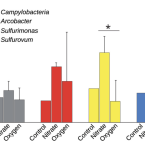
Abstract:
Molecular surveys of low temperature deep-sea hydrothermal vent fluids have shown that Campylobacteria (previously Epsilonproteobacteria) often dominate the microbial community and that three genera, Arcobacter, Sulfurimonas, and Sulfurovum, frequently coexist. In this study, we used replicated radiocarbon incubations of deep-sea hydrothermal fluids to investigate activity of each genus under three experimental conditions. To quantify genus-specific radiocarbon incorporation, we used newly designed oligonucleotide probes for Arcobacter, Sulfurimonas, and Sulfurovum to quantify their activity using catalyzed-reporter deposition fluorescence in situhybridization (CARD-FISH) combined with fluorescence-activated cell sorting. All three genera actively fixed CO2 in short-term (∼ 20 h) incubations, but responded differently to the additions of nitrate and oxygen. Oxygen additions had the largest effect on community composition, and caused a pronounced shift in community composition at the amplicon sequence variant (ASV) level after only 20 h of incubation. The effect of oxygen on carbon fixation rates appeared to depend on the initial starting community. The presented results support the hypothesis that these chemoautotrophic genera possess functionally redundant core metabolic capabilities, but also reveal finer-scale differences in growth likely reflecting adaptation of physiologically-distinct phylotypes to varying oxygen concentrations in situ. Overall, our study provides new insights into how oxygen controls community composition and total chemoautotrophic activity, and underscores how quickly deep-sea vent microbial communities respond to disturbances. IMPORTANCE Sulfidic environments worldwide are often dominated by sulfur-oxidizing, carbon-fixing Campylobacteria. Environmental factors associated with this group's dominance are now understood, but far less is known about the ecology and physiology of members of subgroups of chemoautotrophic Campylobacteria. In this study, we used a novel method to differentiate the genus-specific chemoautotrophic activity of three subtypes of Campylobacteria. In combination with evidence from microscopic counts, chemical consumption/production during incubations, and DNA-based measurements, our data show that oxygen concentration affects both community composition and chemoautotrophic function in situ. These results help us better understand factors controlling microbial diversity at deep-sea hydrothermal vents, and provide first-order insights into the ecophysiological differences between these distinct microbial taxa.
In situ abundance and carbon fixation activity of distinct anoxygenic phototrophs in the stratified seawater lake Rogoznica.
2019 - Environ. Microbiol., 10: 3896-3908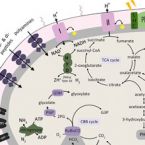
Abstract:
Sulphide-driven anoxygenic photosynthesis is an ancient microbial metabolism that contributes significantly to inorganic carbon fixation in stratified, sulphidic water bodies. Methods commonly applied to quantify inorganic carbon fixation by anoxygenic phototrophs, however, cannot resolve the contributions of distinct microbial populations to the overall process. We implemented a straightforward workflow, consisting of radioisotope labelling and flow cytometric cell sorting based on the distinct autofluorescence of bacterial photopigments, to discriminate and quantify contributions of co-occurring anoxygenic phototrophic populations to in situ inorganic carbon fixation in environmental samples. This allowed us to assign 89.3% ± 7.6% of daytime inorganic carbon fixation by anoxygenic phototrophs in Lake Rogoznica (Croatia) to an abundant chemocline-dwelling population of green sulphur bacteria (dominated by Chlorobium phaeobacteroides), whereas the co-occurring purple sulphur bacteria (Halochromatium sp.) contributed only 1.8% ± 1.4%. Furthermore, we obtained two metagenome assembled genomes of green sulphur bacteria and one of a purple sulphur bacterium which provides the first genomic insights into the genus Halochromatium, confirming its high metabolic flexibility and physiological potential for mixo- and heterotrophic growth.
Transcriptomic and proteomic insight into the mechanism of cyclooctasulfur- versus thiosulfate-oxidation by the chemolithoautotroph Sulfurimonas denitrificans.
2019 - Environ. Microbiol., 1: 244-258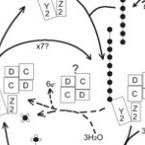
Abstract:
Chemoautotrophic bacteria belonging to the genus Sulfurimonas (class Campylobacteria) were previously identified as key players in the turnover of zero-valence sulfur, a central intermediate in the marine sulfur cycle. S. denitrificans was further shown to be able to oxidize cyclooctasulfur (S ). However, at present the mechanism of activation and metabolism of cyclooctasulfur is not known. Here, we assessed the transcriptome and proteome of S. denitrificans grown with either thiosulfate or S as the electron donor. While the overall expression profiles under the two growth conditions were rather similar, distinct differences were observed that could be attributed to the utilization of S . This included a higher abundance of expressed genes related to surface attachment in the presence of S , and the differential regulation of the sulfur-oxidation multienzyme complex (SOX), which in S. denitrificans is encoded in two gene clusters: soxABXY Z and soxCDY Z . While the proteins of both clusters were present with thiosulfate, only proteins of the soxCDY Z were detected at significant levels with S . Based on these findings a model for the oxidation of S is proposed. Our results have implications for interpreting metatranscriptomic and -proteomic data and for the observed high level of diversification of soxY Z among sulfur-oxidizing Campylobacteria.
Metabolic specialization of denitrifiers in permeable sediments controls NO emissions
2018 - Environ Microbiol, 12: 4486-4502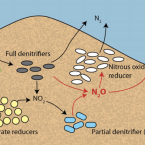
Abstract:
Coastal oceans receive large amounts of anthropogenic fixed nitrogen (N), most of which is denitrified in the sediment before reaching the open ocean. Sandy sediments, which are common in coastal regions, seem to play an important role in catalysing this N-loss. Permeable sediments are characterized by advective porewater transport, which supplies high fluxes of organic matter into the sediment, but also leads to fluctuations in oxygen and nitrate concentrations. Little is known about how the denitrifying communities in these sediments are adapted to such fluctuations. Our combined results indicate that denitrification in eutrophied sandy sediments from the world's largest tidal flat system, the Wadden Sea, is carried out by different groups of microorganisms. This segregation leads to the formation of NO which is advectively transported to the overlying waters and thereby emitted to the atmosphere. At the same time, the production of NO within the sediment supports a subset of Flavobacteriia which appear to be specialized on NO reduction. If the mechanisms shown here are active in other coastal zones, then denitrification in eutrophied sandy sediments may substantially contribute to current marine NO emissions.
Evidence for H2 consumption by uncultured Desulfobacterales in coastal sediments.
2018 - Environ. Microbiol., 2: 450-461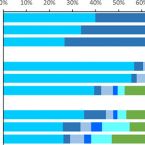
Abstract:
Molecular hydrogen (H ) is the key intermediate in the anaerobic degradation of organic matter. Its removal by H -oxidizing microorganisms is essential to keep anaerobic degradation energetically favourable. Sulfate-reducing microorganisms (SRM) are known as the main H scavengers in anoxic marine sediments. Although the community of marine SRM has been extensively studied, those consuming H in situ are completely unknown. We combined metagenomics, PCR-based clone libraries, single-amplified genomes (SAGs) and metatranscriptomics to identify potentially H -consuming SRM in anoxic coastal sediments. The vast majority of SRM-related H ase sequences were assigned to group 1b and 1c [NiFe]-H ases of the deltaproteobacterial order Desulfobacterales. Surprisingly, the same sequence types were similarly highly expressed in spring and summer, suggesting that these are stable and integral members of the H -consuming community. Notably, one sequence cluster from the SRM group 1 consistently accounted for around half of all [NiFe]-H ase transcripts. Using SAGs, we could link this cluster with the 16S rRNA genes of the uncultured Sva0081-group of the family Desulfobacteraceae. Sequencing of 16S rRNA gene amplicons and H ase gene libraries suggested consistently high in situ abundance of the Sva0081 group also in other marine sediments. Together with other Desulfobacterales these likely are important H -scavengers in marine sediments.
The life sulfuric: microbial ecology of sulfur cycling in marine sediments.
2017 - Environ Microbiol Rep, 4: 323-344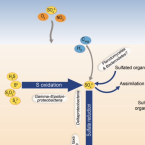
Abstract:
Almost the entire seafloor is covered with sediments that can be more than 10 000 m thick and represent a vast microbial ecosystem that is a major component of Earth's element and energy cycles. Notably, a significant proportion of microbial life in marine sediments can exploit energy conserved during transformations of sulfur compounds among different redox states. Sulfur cycling, which is primarily driven by sulfate reduction, is tightly interwoven with other important element cycles (carbon, nitrogen, iron, manganese) and therefore has profound implications for both cellular- and ecosystem-level processes. Sulfur-transforming microorganisms have evolved diverse genetic, metabolic, and in some cases, peculiar phenotypic features to fill an array of ecological niches in marine sediments. Here, we review recent and selected findings on the microbial guilds that are involved in the transformation of different sulfur compounds in marine sediments and emphasise how these are interlinked and have a major influence on ecology and biogeochemistry in the seafloor. Extraordinary discoveries have increased our knowledge on microbial sulfur cycling, mainly in sulfate-rich surface sediments, yet many questions remain regarding how sulfur redox processes may sustain the deep-subsurface biosphere and the impact of organic sulfur compounds on the marine sulfur cycle.
Unexpected genomic features in widespread intracellular bacteria: evidence for motility of marine chlamydiae.
2017 - ISME J, 10: 2334-2344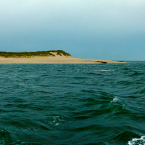
Abstract:
Chlamydiae are obligate intracellular bacteria comprising important human pathogens and symbionts of protists. Molecular evidence indicates a tremendous diversity of chlamydiae particularly in marine environments, yet our current knowledge is based mainly on terrestrial representatives. Here we provide first insights into the biology of marine chlamydiae representing three divergent clades. Our analysis of single-cell amplified genomes revealed hallmarks of the chlamydial lifestyle, supporting the ancient origin of their characteristic developmental cycle and major virulence mechanisms. Surprisingly, these chlamydial genomes encode a complete flagellar apparatus, a previously unreported feature. We show that flagella are an ancient trait that was subject to differential gene loss among extant chlamydiae. Together with a chemotaxis system, these marine chlamydiae are likely motile, with flagella potentially playing a role during host cell infection. This study broadens our view on chlamydial biology and indicates a largely underestimated potential to adapt to different hosts and environments.
Genomic repertoire of the Woeseiaceae/JTB255, cosmopolitan and abundant core members of microbial communities in marine sediments.
2017 - ISME J, 5: 1276-1281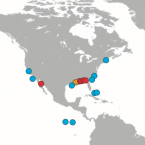
Abstract:
To date, very little is known about the bacterial core community of marine sediments. Here we study the environmental distribution, abundance and ecogenomics of the gammaproteobacterial Woeseiaceae/JTB255 marine benthic group. A meta-analysis of published work shows that the Woeseiaceae/JTB255 are ubiquitous and consistently rank among the most abundant 16S rRNA gene sequences in diverse marine sediments. They account for up to 22% of bacterial amplicons and 6% of total cell counts in European and Australian coastal sediments. The analysis of a single-cell genome, metagenomic bins and the genome of the next cultured relative Woeseia oceani indicated a broad physiological range, including heterotrophy and facultative autotrophy. All tested (meta)genomes encode a truncated denitrification pathway to nitrous oxide. The broad range of energy-yielding metabolisms possibly explains the ubiquity and high abundance of Woeseiaceae/JTB255 in marine sediments, where they carry out diverse, but yet unknown ecological functions.
Colonization of freshwater biofilms by nitrifying bacteria from activated sludge
2013 - FEMS Microbiol Ecol, 85: 104-115
Abstract:
Effluents from wastewater treatment plants (WWTPs) containing micro-organisms and residual nitrogen can stimulate nitrification in freshwater streams. We hypothesized that different ammonia-oxidizing (AOB) and nitrite-oxidizing (NOB) bacteria present in WWTP effluents differ in their potential to colonize biofilms in the receiving streams. In an experimental approach, we monitored biofilm colonization by nitrifiers in ammonium- or nitrite-fed microcosm flumes after inoculation with activated sludge. In a field study, we compared the nitrifier communities in a full-scale WWTP and in epilithic biofilms downstream of the WWTP outlet. Despite substantially different ammonia concentrations in the microcosms and the stream, the same nitrifiers were detected by fluorescence in situ hybridization in all biofilms. Of the diverse nitrifiers present in the WWTPs, only AOB of the Nitrosomonas oligotropha/ureae lineage and NOB of Nitrospira sublineage I colonized the natural biofilms. Analysis of the amoA gene encoding the alpha subunit of ammonia monooxygenase of AOB revealed seven identical amoA sequence types. Six of these affiliated with the N. oligotropha/ureae lineage and were shared between the WWTP and the stream biofilms, but the other shared sequence type grouped with the N. europaea/eutropha and N. communis lineage. Measured nitrification activities were high in the microcosms and the stream. Our results show that nitrifiers from WWTPs can colonize freshwater biofilms and confirm that WWTP-affected streams are hot spots of nitrification.
Thaumarchaeotes abundant in refinery nitrifying sludges express amoA but are not obligate autotrophic ammonia oxidizers
2011 - Proc. Natl. Acad. Sci. USA, 108: 16771-16776
Abstract:
Nitrification is a core process in the global nitrogen cycle that is essential for the functioning of many ecosystems. The discovery of autotrophic ammonia-oxidizing archaea (AOA) within the phylum Thaumarchaeota has changed our perception of the microbiology of nitrification, in particular since their numerical dominance over ammonia-oxidizing bacteria (AOB) in many environments has been revealed. These and other data have led to a widely held assumption that all amoA-encoding members of the Thaumarchaeota (AEA) are autotrophic nitrifiers. In this study, 52 municipal and industrial wastewater treatment plants were screened for the presence of AEA and AOB. Thaumarchaeota carrying amoA were detected in high abundance only in four industrial plants. In one plant, thaumarchaeotes closely related to soil group I.1b outnumbered AOB up to 10,000-fold, and their numbers, which can only be explained by active growth in this continuous culture system, were two to three orders of magnitude higher than could be sustained by autotrophic ammonia oxidation. Consistently, (14)CO(2) fixation could only be detected in AOB but not in AEA in actively nitrifying sludge from this plant via FISH combined with microautoradiography. Furthermore, in situ transcription of archaeal amoA, and very weak in situ labeling of crenarchaeol after addition of (13)CO(2), was independent of the addition of ammonium. These data demonstrate that some amoA-carrying group I.1b Thaumarchaeota are not obligate chemolithoautotrophs.
Drivers of bacterial colonization patterns in stream biofilms
2010 - FEMS Microbiol. Ecol., 72: 47-57
Abstract:
Dispersal and colonization are important for the assembly and biodiversity of microbial communities. While emigration as the initial step of dispersal has become increasingly understood in model bacterial biofilms, the drivers of dispersal and colonization in complex biofilms remain elusive. We grew complex biofilms in microcosms from natural surface water in laminar and turbulent flow, and investigated dispersal and colonization patterns of fluorescently labeled cells and microbeads in nascent and mature biofilms. Settling occurred in nonrandom spatial patterns governed by the interplay of local flow patterns and biofilm topography. Settling was higher in treatments with nascent biofilms, with fewer cells remaining in the water column than in treatments with mature biofilms. The flow regime had no effect on settling velocity, even though in mature biofilms the formation of streamers under turbulent flow enhanced particle trapping compared with the laminar flow treatment. Hence, small-scale variations in the flow pattern seemed to be more important than the overall flow regime. Furthermore, spatial analysis of the colonizer patterns suggests that bacteria have moved in the biofilm after settling. Our results show that colonization of biofilms in a model stream environment is a heterogeneous process differently affected by biological and physical factors.
Detoxification of sulphidic African shelf waters by blooming chemolithotrophs
2009 - Nature, 457: 581-584
Abstract:
Coastal waters support ~90% of global fisheries and, as such, are an important food reserve for our planet1. Eutrophication of these waters, due to human activity, leads to severe oxygen depletion and the episodic occurrence of hydrogen sulphide a toxin for multi-cellular life with disastrous consequences for coastal ecosytems. Here, we show that an area of ~7,000 km2 of African shelf, covered by sulphidic water, was detoxified by blooming bacteria, which oxidized the biologically harmful sulphide to environmentally-harmless colloidal sulphur and sulphate. Combined chemical analyses, stoichiometric modelling, isotopic incubations, comparative 16S ribosomal RNA, functional gene sequence analyses and fluorescence in situ hybridization (FISH) indicate that the detoxification proceeded by chemolithotrophic oxidation of sulphide with nitrate and was mainly catalyzed by two discrete populations of Gamma- and Epsilonproteobacteria. Chemolithotrophic bacteria, accounting for ~20% of the bacterioplankton in sulphidic waters, created a buffer zone between the toxic sulphidic subsurface waters and the oxic surface waters, where fish and other nekton live. This is the first time that large-scale detoxification of sulphidic waters by chemolithotrophs has been shown in an open-ocean system. The data suggest that sulphide can be completely consumed by bacteria in the subsurface waters, and thus, can be overlooked by remote sensing or monitoring of shallow coastal waters. Consequently, sulphidic bottom waters on continental shelves may be more frequent than previously believed, and as such, could have an important but as-yet neglected effect on benthic communities.
Reverse dissimilatory sulfite reductase as phylogenetic marker for a subgroup of sulfur-oxidizing prokaryotes
2009 - Environ. Microbiol., 11: 289-299
Abstract:
Sulfur-oxidizing prokaryotes (SOP) catalyse a central step in the global S-cycle and are of major functional importance for a variety of natural and engineered systems, but our knowledge on their actual diversity and environmental distribution patterns is still rather limited. In this study we developed a specific PCR assay for the detection of dsrAB that encode the reversely operating sirohaem dissimilatory sulfite reductase (rDSR) and are present in many but not all published genomes of SOP. The PCR assay was used to screen 42 strains of SOP (most without published genome sequence) representing the recognized diversity of this guild. For 13 of these strains dsrAB was detected and the respective PCR product was sequenced. Interestingly, most dsrAB-encoding SOP are capable of forming sulfur storage compounds. Phylogenetic analysis demonstrated largely congruent rDSR and 16S rRNA consensus tree topologies, indicating that lateral transfer events did not play an important role in the evolutionary history of known rDSR. Thus, this enzyme represents a suitable phylogenetic marker for diversity analyses of sulfur storage compound-exploiting SOP in the environment. The potential of this new functional gene approach was demonstrated by comparative sequence analyses of all dsrAB present in published metagenomes and by applying it for a SOP census in selected marine worms and an alkaline lake sediment.
Identity and abundance of active sulfate-reducing bacteria in deep tidal flat sediments determined by directed cultivation and CARD-FISH analysis
2008 - Environ. Microbiol., 10: 2645-2659
Abstract:
The identity and abundance of potentially active sulfate-reducing bacteria (SRB) in several metre deep sediments of a tidal sand flat in the German Wadden Sea were assessed by directed cultivation and cultivation-independent CARD-FISH analysis (catalysed reporter deposition fluorescence in situ hybridization). Presumably abundant SRB from different sediment layers between 0.5 and 4 m depth were selectively enriched in up to million-fold diluted cultures supplemented with lactate, acetate or hydrogen. Partial 16S rRNA gene sequences obtained from highest dilution steps showing sulfide formation indicated growth of deltaproteobacterial SRB belonging to the Desulfobulbaceae and the Desulfobacteraceae as well as of members of the Firmicutes. Subsequent isolation resulted in 10 novel phylotypes of both litho- and organotrophic sulfate-reducing Deltaproteobacteria. Molecular pre-screening identified six isolates as members of the Desulfobulbaceae, sharing highest identities with either candidatus 'Desulfobacterium corrodens' (95-97%) or Desulfobacterium catecholicum (98%), and four isolates as members of Desulfobacteraceae, being related to either Desulfobacter psychrotolerans (98%) or Desulfobacula phenolica (95-97%). Relatives of D. phenolica were exlusively isolated from 50 and 100 cm deep sediments with 10 and 2 mM of pore water sulfate respectively. In contrast, relatives of D. corrodens, D. psychrotolerans and D. catecholicum were also obtained from layers deeper than 100 cm and with less than 2 mM sulfate. The high in situ abundance of members of both families in sediment layers beneath 50 cm could be confirmed via CARD-FISH analysis performed with a set of six SRB-specific oligonucleotide probes. Moreover, SRB represented a numerically significant fraction of the microbial community throughout the sediment (up to 7%) and reached even higher cell numbers in deep, sulfate-poor layers than in the sulfate-rich surface sediment. This relatively large community size of potentially active SRB in deep sandy sediments might on the one hand be a result of their syntrophic association with other anaerobes. Our results furthermore support the hypothesis that enhanced advective pore water transport might supply nutrients to microbial communities in deep sandy sediments and point to their so far unrecognized contribution to biogeochemical processes in Wadden Sea sediments.
Dethiobacter alkaliphilus gen. nov. sp. nov., and Desulfurivibrio alkaliphilus gen. nov. sp. nov.: two novel representatives of reductive sulfur cycle from soda lakes
2008 - Extremophiles, 12: 431-439
Abstract:
Anaerobic enrichments with H2 as electron donor and thiosulfate/polysulfide as electron acceptor at pH 10 and 0.6 M total Na+ yielded two non sulfate-reducing representatives of reductive sulfur cycle from soda lake sediments. Strain AHT 1 was isolated with thiosulfate as the electron acceptor from north-eastern Mongolian soda lakes and strain AHT 2-with polysulfide as the electron acceptor from Wadi al Natrun lakes in Egypt. Both isolates represented new phylogenetic lineages: AHT 1-within Clostridiales and AHT 2-within the Deltaproteobacteria. Both bacteria are obligate anaerobes with respiratory metabolism. Both grew chemolithoautotrophically with H2 as the electron donor and can use thiosulfate, elemental sulfur and polysulfide as the electron acceptors. AHT 2 also used nitrate as acceptor, reducing it to ammonia. During thiosulfate reduction, AHT 1 excreted sulfite. dsrAB gene was not found in either strain. Both strains were moderate salt-tolerant (grow up to 2 M total Na+) true alkaliphiles (grow between pH 8.5 and 10.3). On the basis of the phenotypic and phylogenetic data, strains AHT 1 and AHT 2 are proposed as new genera and species Dethiobacter alkaliphilus and Desulfurivibrio alkaliphilus, respectively.
Physiological adaptation of a nitrate-storing Beggiatoa sp. to diel cycling in a phototrophic hypersaline mat
2008 - Appl. Environ. Microbiol., 73: 7013-7022
Abstract:
The aim of this study was to investigate the supposed vertical diel migration and the accompanying physiology of Beggiatoa bacteria from hypersaline microbial mats. We combined microsensor, stable-isotope, and molecular techniques to clarify the phylogeny and physiology of the most dominant species inhabiting mats of the natural hypersaline Lake Chiprana, Spain. The most dominant morphotype had a filament diameter of 6 to 8 microm and a length varying from 1 to >10 mm. Phylogenetic analysis by 16S rRNA gene comparison revealed that this type appeared to be most closely related (91% sequence identity) to the narrow (4-microm diameter) nonvacuolated marine strain MS-81-6. Stable-isotope analysis showed that the Lake Chiprana species could store nitrate intracellularly to 40 mM. The presence of large intracellular vacuoles was confirmed by fluorescein isothiocyanate staining and subsequent confocal microscopy. In illuminated mats, their highest abundance was found at a depth of 8 mm, where oxygen and sulfide co-occurred. However, in the dark, the highest Beggiatoa densities occurred at 7 mm, and the whole population was present in the anoxic zone of the mat. Our findings suggest that hypersaline Beggiatoa bacteria oxidize sulfide with oxygen under light conditions and with internally stored nitrate under dark conditions. It was concluded that nitrate storage by Beggiatoa is an optimal strategy to both occupy the suboxic zones in sulfidic sediments and survive the dark periods in phototrophic mats.




